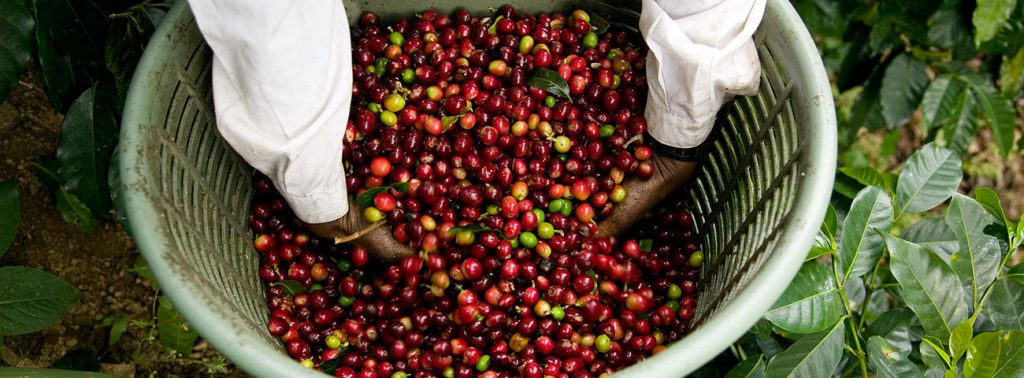Coffee is such an important part of everyday life that few of us stop to think about what goes into growing the beans that make this hugely popular drink.

The history and importance of coffee
Legend has it that the energising effect of the coffee bean was first recognised by a 9th-century goatherd in the Kaffa province of Ethiopia, where the coffee tree originated. Coffee was almost certainly cultivated in Yemen long before the 15th century when Sufi mystics reportedly drank it to keep awake during extended hours of prayer.
The drink was spread by Muslim pilgrims and traders across North Africa and the Middle East, where Arabian coffeehouses became centres of political activity. The Dutch planted coffee in Sri Lanka, India and Java in the late 1600s and later in South America.
Within a few years, Dutch colonies became the main suppliers of coffee to Europe, its production associated with colonial expansion and slavery. Coffee soon became one of the most valuable primary products in world trade. The first UK coffee house was opened in Oxford in 1650, followed two years later by one in London.
The rise of global coffee consumption
Global coffee consumption has more than doubled over the last 50 years, from 4.2m tonnes in 1970 to over 10m tonnes in 2019/20. Coffee-producing countries consume 30 per cent of the world’s coffee, led by Brazil, whose consumption reached 1.3 million tonnes in 2019/20. The remaining 70 per cent of coffee produced is traded internationally; the US is the biggest importer, followed by Germany and Italy, while the UK is the 8th largest importer within the European Union, accounting for 3% of world coffee imports.
Coffee is grown in more than 70 countries, but nearly 70 per cent of the world’s coffee is produced by just four of them – Brazil, Vietnam, Colombia and Indonesia. Latin America is the largest regional producer with a 59 per cent share, followed by Asia and Oceania (30%) and Africa (11%).
For countries that produce it, coffee exports generate a significant proportion of national income and are a vital source of the foreign exchange earnings that governments rely on to improve health, education, infrastructure and other social services.
For instance, Honduras relies on coffee for nearly a quarter of its export earnings, and in Nicaragua, over 15 per cent of the labour market is employed in coffee production. In Ethiopia, 15 million smallholders, nearly a fifth of the population, depend on coffee for their livelihood, and it generates around a third of the country’s total export earnings. In Uganda, 1.7 million households grow coffee, and it contributes to nearly 20 per cent of the country’s export earnings.
The challenges facing coffee farmers
The global coffee sector faces many challenges in the next decade, including the continuing global economic crisis, volatile coffee prices, shortages of coffee supply from key origins, rising production costs, reduced availability of land and labour, food security and poverty in coffee communities, and the impact of climate change.
Coffee supply chains
The value of the global coffee market is an estimated $102 billion, while the UK coffee shop market has an estimated value of £10.1 billion. Coffee supply chains are often complex, with beans sometimes changing hands dozens of times on the journey from grower to consumer.
The coffee supply chain has long been dominated by a small number of multinational trading and roasting companies. A recent period of accelerated consolidation in the coffee market means that more than 80 per cent of global sales are now attributed to just three multinational corporations.
Retail value of coffee
But while coffee is clearly profitable for food companies, it’s a very different story for coffee farmers. The share of the retail value of coffee retained by the producer has fallen over the decades – in the 1970s producers retained an average of 20 per cent of the retail price of coffee sold in a shop.
When oversupply caused prices to crash to historic lows during the coffee crisis of 1994 – 2004, research found coffee growers received just 1-3 per cent of the price of a cup of coffee sold in a café in Europe or North America and 2-6 per cent of the value of coffee sold in a supermarket.
Volatility of world coffee prices
Farmers are also the worst affected by the notorious volatility of world coffee prices. In recent years, the price of Arabica coffee has swung from a 30-year low of 45 cents a pound in 2001 to a 34-year high of almost 309 cents in 2011. Between May 2011 and December 2013, prices fell by 65% as a result of the Euro crisis and oversupply of coffee.
After a drought in Brazil saw prices rise briefly in 2014, prices fell back to a range of 115 to 145 cents a pound in 2015 and 2016. This price volatility has significant consequences for those who depend on coffee for their livelihood, making it difficult for growers to predict their income for the coming season and budget for their household and farming needs.
When prices are low, farmers have neither the incentive nor resources to invest in good maintenance of their farms by applying fertilisers and pesticides or replacing old trees. When prices fall below the costs of production, farmers struggle to put adequate food on the table and pay medical bills and school fees.
Climate crisis
Growing coffee is further complicated by the impacts of the climate crisis that have caused disturbances to weather patterns and temperatures in producing countries, increasing the risks faced by farmers depending on coffee sales.
How is Fairtrade making things better?
Fairtrade was started in response to the dire struggles of Mexican coffee farmers following the collapse of world coffee prices in the late 1980s.
From the 1960s until 1989, the coffee market kept a reasonable balance of supply and demand in part due to the 1962 International Coffee Agreement (ICA) and subsequent agreements signed by governments of producing and consuming countries. The ICA regulated much of the global coffee trade through a system of export quotas and buffer stocks, which largely maintained stable and remunerative prices to growers.
The economic clauses of the ICA were suspended in 1989 because of abuse of the quota system and their incompatibility with prevalent free market economic policies. Controversial IMF and World Bank structural adjustment programmes (SAP) required governments of producing countries to privatise state-controlled industries such as the coffee sector and open them to competition from private traders, ostensibly to improve efficiency.
As a consequence, world coffee prices immediately dropped by half to less than 80 cents a pound.
The collapse of the International Coffee Agreement and subsequent price crash was a major factor in the launch of the first Fairtrade label, Max Havelaar, under the initiative of the Dutch development agency Solidaridad. The first ‘Fairtrade’ coffee from Mexico was sold in Dutch supermarkets in 1989. It was branded Max Havelaar, after a fictional Dutch character who opposed the exploitation of coffee pickers in Dutch colonies.
Fairtrade was set up to ensure coffee farmers receive a fair and stable price for their coffee that covers the average costs of sustainable production.
Fairtrade Minimum Price
Fairtrade certified co-operatives can count on at least the Fairtrade Minimum Price for arabica coffee sold on Fairtrade terms (30 cents more if organic), plus an extra 20 cents per pound Fairtrade Premium to invest as they see fit – 5 cents of which is dedicated to improving productivity and quality.
These tools give farmers the stability and confidence to budget for the next farming season and household expenses and drive development in their communities. For 15 of the last 25 years, when the global price for arabica coffee has often fallen well below the Fairtrade Minimum Price, it has ensured farmers can earn enough to cover at least the basic costs of sustainable production.
Fairtrade currently works with over 838,000 coffee farmers globally through 656 Fairtrade-certified coffee producer organisations. In 2020, Fairtrade coffee farmers cultivated coffee on more than 1,127,000 hectares worldwide, producing 889,500 tonnes of coffee.
Fairtrade increase coffee Minimum Price
The new Fairtrade prices, which come into effect for contracts signed as of 1 August 2023, will increase the baseline price by 19 percent and 29 percent for Fairtrade-certified Robusta and Arabica coffee, respectively.
This will provide farmers with significant price risk management support in times of wild market fluctuation, covering their needs as they face inflation in their home countries and substantial additional costs due to climate change adaption.
The new Fairtrade Minimum Price for washed Arabica beans – which represent more than 80 percent of all Fairtrade coffee sold – is $1.80 per pound, an increase of 40 cents over the previous price of $1.40 per pound.
For natural Robusta, the price will increase by 19 cents to $1.20 per pound. The additional value for organic Fairtrade coffee has been increased by a third, from 30 cents to 40 cents per pound.
Fairtrade Premium
The Fairtrade Premium is valuable additional capital that allows farmer organisations to reinvest in improving infrastructure services to farmers, such as training on better farming practices or credit and financial services, but also to support cash payments to farmer members who are struggling with food security or other basic needs. Fairtrade Standards are designed to deliver against all three pillars of sustainability – economic, social and environmental.
Training and support
In addition to the Fairtrade Minimum Price and Fairtrade Premium, Fairtrade provides essential training and support to farmer organisations to help them thrive.
One of the main focus areas is to train farmers to adapt better to changing climate and weather conditions. Keeping the next generation engaged in the coffee sector is one of the challenges facing the industry.
Find out more about the Fairtrade International Climate Change Programme(PDF) and how Fairtrade coffee farmers are adapting to climate change: Fairtrade climate and environment.
